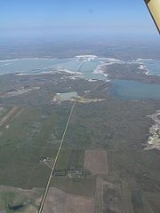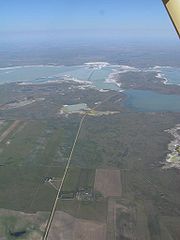
Chaplin, Saskatchewan
Encyclopedia
Chaplin is a rural village in Saskatchewan
, Canada
situated on the Trans-Canada Highway
approximately 85 km from Moose Jaw
and 90 km from Swift Current
. The main industries of Chaplin are Saskatchewan Minerals
and farming/ ranching. Chaplin consists of eight streets, two crescents, and four avenues (including the avenue on the 'other side of the (train) tracks'). At the 2001 census, it had a population of 292.
Chaplin is governed by an elected Mayor and five councilors. The village employs a Village Administrator, Village Foreperson, and on Saturdays an additional individual who works at the Village Dump administering public waste disposal (there is also weekly curb-side trash pick-up).
 Chaplin is situated on the Trans-Canada Highway
Chaplin is situated on the Trans-Canada Highway
between Moose Jaw and Swift Current, and on the north edge of Chaplin Lake. The lake encompasses nearly 20 square miles (51.8 km²) and is the second largest saline water body in Canada. The area is noted from the Western Hemispheric Shorebird Reserve Network (WHSRN) for its shorebirds. Chaplin Lake was designated a Western Hemispheric Shorebird Reserve Network site in May 1997. This is the highest designation that a reserve can receive and there are only 35 sites recognized in the Western Hemisphere (only 5 of them being in Canada).
Shorebird surveys conducted by the Saskatchewan Wetlands Conservation Corporation and Environment Canada
's Canadian Wildlife Service
revealed that over 30 species, with a peak count of 67,000 birds in a day, use the lake. More than 50,000 sanderling
s, or about 25-50% of their hemispheric population, were counted in a single day in and around Chaplin Lake. This area is also one of the top four breeding areas in Saskatchewan for the piping plover
, an endangered species whose principal breeding area is in Saskatchewan.
As well as being the home for shorebirds, the main business of Chaplin also uses the sodium sulphate deposits of Chaplin Lake. Saskatchewan Minerals, a private company, harvests the sodium sulphate through an evaporation method; large salt deposits are visible from the Trans-Canada Highway. Additionally, Artemia Canada, a seasonal company, catches and packages the brine shrimp that thrive in the salt water of Chaplin Lake. Both of these industries support the needs of shorebirds by ensuring an adequate supply of water in the spring and summer.
For many North American shorebirds, the Chaplin area fulfills their needs. The area is a bounty of delight for the birds as they banquet on shore flies, brine shrimp, midge larval, and seeds from the salty shores and shallow waters. They can rest between eating with few predators to be concerned about. Those birds that briefly stop in Chaplin on their way to nest in the high arctic, dine and fatten here by the thousands in May, and return followed by their young in August and September.
An interpretive centre near the village of Chaplin offers a wealth of information about the birds, the brine shrimp industry and this areas significance as it connects to the hemispheric web of migration. Bus tours are available daily during their summer season, which lasts from the long weekend in May to the long weekend in September. Shorebirds, wildlife, conservation,local industries and agriculture will all be included in the tours. Also a short reach FM radio station that covers a 30 miles (48.3 km) radius around Chaplin with recorded messages that explain the value of shorebird habitat in the area and encourage tourists to stop and tour the area.
In a pattern repeated for thousands of years, shorebirds link their winter stations in South America with the spring and summer nesting in Canada's prairies and high Arctic. During their passage with some birds flying more than 70 hours and over 5000 km (3,106.9 mi) between stops, it is critical their needs be met.
Saskatchewan
Saskatchewan is a prairie province in Canada, which has an area of . Saskatchewan is bordered on the west by Alberta, on the north by the Northwest Territories, on the east by Manitoba, and on the south by the U.S. states of Montana and North Dakota....
, Canada
Canada
Canada is a North American country consisting of ten provinces and three territories. Located in the northern part of the continent, it extends from the Atlantic Ocean in the east to the Pacific Ocean in the west, and northward into the Arctic Ocean...
situated on the Trans-Canada Highway
Trans-Canada Highway
The Trans-Canada Highway is a federal-provincial highway system that joins the ten provinces of Canada. It is, along with the Trans-Siberian Highway and Australia's Highway 1, one of the world's longest national highways, with the main route spanning 8,030 km...
approximately 85 km from Moose Jaw
Moose Jaw, Saskatchewan
Moose Jaw is a city in south-central Saskatchewan, Canada on the Moose Jaw River. It is situated on the Trans-Canada Highway, west of Regina. Residents of Moose Jaw are known as Moose Javians. It is best known as a retirement and tourist city that serves as a hub to the hundreds of small towns...
and 90 km from Swift Current
Swift Current, Saskatchewan
Swift Current is a small city in southwest Saskatchewan. It is situated along the Trans Canada Highway west from Moose Jaw, and east from Medicine Hat, Alberta. Swift Current grew 0.8% between 2001 and 2006 ending up at 14,946 residents. The city is surrounded by the Rural Municipality of Swift...
. The main industries of Chaplin are Saskatchewan Minerals
Saskatchewan Minerals
Saskatchewan Minerals Inc. is a privately held company located in Saskatchewan, Canada, that mines and processes sodium sulphate. Originally established as a crown corporation in 1947. Today the company is one of the largest producers of anhydrous sodium sulphate in North America with production...
and farming/ ranching. Chaplin consists of eight streets, two crescents, and four avenues (including the avenue on the 'other side of the (train) tracks'). At the 2001 census, it had a population of 292.
Chaplin is governed by an elected Mayor and five councilors. The village employs a Village Administrator, Village Foreperson, and on Saturdays an additional individual who works at the Village Dump administering public waste disposal (there is also weekly curb-side trash pick-up).
Chaplin Lake and shorebirds

Trans-Canada Highway
The Trans-Canada Highway is a federal-provincial highway system that joins the ten provinces of Canada. It is, along with the Trans-Siberian Highway and Australia's Highway 1, one of the world's longest national highways, with the main route spanning 8,030 km...
between Moose Jaw and Swift Current, and on the north edge of Chaplin Lake. The lake encompasses nearly 20 square miles (51.8 km²) and is the second largest saline water body in Canada. The area is noted from the Western Hemispheric Shorebird Reserve Network (WHSRN) for its shorebirds. Chaplin Lake was designated a Western Hemispheric Shorebird Reserve Network site in May 1997. This is the highest designation that a reserve can receive and there are only 35 sites recognized in the Western Hemisphere (only 5 of them being in Canada).
Shorebird surveys conducted by the Saskatchewan Wetlands Conservation Corporation and Environment Canada
Environment Canada
Environment Canada , legally incorporated as the Department of the Environment under the Department of the Environment Act Environment Canada (EC) (French: Environnement Canada), legally incorporated as the Department of the Environment under the Department of the Environment Act Environment...
's Canadian Wildlife Service
Canadian Wildlife Service
The Canadian Wildlife Service or CWS is a branch of the Department of the Environment, also known as Environment Canada, a department of the Government of Canada....
revealed that over 30 species, with a peak count of 67,000 birds in a day, use the lake. More than 50,000 sanderling
Sanderling
The Sanderling is a small wader. It is a circumpolar Arctic breeder, and is a long-distance migrant, wintering south to South America, South Europe, Africa, and Australia...
s, or about 25-50% of their hemispheric population, were counted in a single day in and around Chaplin Lake. This area is also one of the top four breeding areas in Saskatchewan for the piping plover
Piping Plover
The Piping Plover is a small sand-colored, sparrow-sized shorebird that nests and feeds along coastal sand and gravel beaches in North America. The adult has yellow-orange legs, a black band across the forehead from eye to eye, and a black ring around the neck...
, an endangered species whose principal breeding area is in Saskatchewan.
As well as being the home for shorebirds, the main business of Chaplin also uses the sodium sulphate deposits of Chaplin Lake. Saskatchewan Minerals, a private company, harvests the sodium sulphate through an evaporation method; large salt deposits are visible from the Trans-Canada Highway. Additionally, Artemia Canada, a seasonal company, catches and packages the brine shrimp that thrive in the salt water of Chaplin Lake. Both of these industries support the needs of shorebirds by ensuring an adequate supply of water in the spring and summer.
For many North American shorebirds, the Chaplin area fulfills their needs. The area is a bounty of delight for the birds as they banquet on shore flies, brine shrimp, midge larval, and seeds from the salty shores and shallow waters. They can rest between eating with few predators to be concerned about. Those birds that briefly stop in Chaplin on their way to nest in the high arctic, dine and fatten here by the thousands in May, and return followed by their young in August and September.
An interpretive centre near the village of Chaplin offers a wealth of information about the birds, the brine shrimp industry and this areas significance as it connects to the hemispheric web of migration. Bus tours are available daily during their summer season, which lasts from the long weekend in May to the long weekend in September. Shorebirds, wildlife, conservation,local industries and agriculture will all be included in the tours. Also a short reach FM radio station that covers a 30 miles (48.3 km) radius around Chaplin with recorded messages that explain the value of shorebird habitat in the area and encourage tourists to stop and tour the area.
In a pattern repeated for thousands of years, shorebirds link their winter stations in South America with the spring and summer nesting in Canada's prairies and high Arctic. During their passage with some birds flying more than 70 hours and over 5000 km (3,106.9 mi) between stops, it is critical their needs be met.

